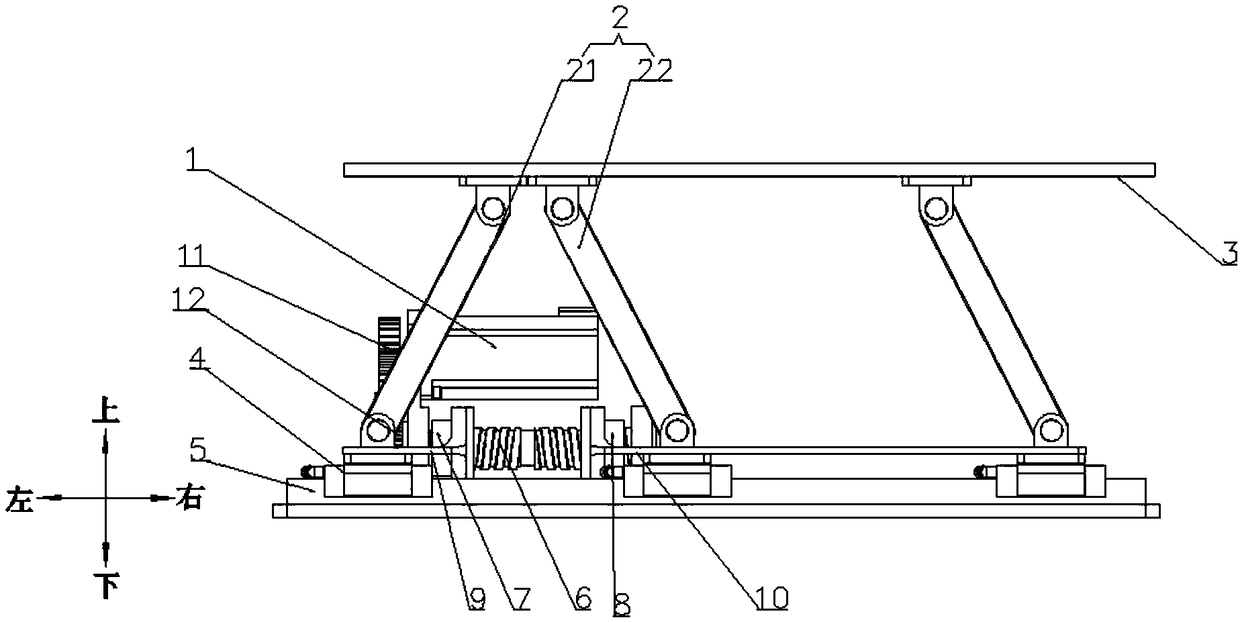Connection rod type AGV lifting device
A lifting device and link-type technology, which is applied in the field of link-type AGV lifting devices, can solve problems such as the complex structure of the AGV lifting device, and achieve the effects of low manufacturing cost, strong synchronization, and convenient installation
- Summary
- Abstract
- Description
- Claims
- Application Information
AI Technical Summary
Problems solved by technology
Method used
Image
Examples
Embodiment 1
[0030] A link-type AGV lifting device, including a power output device 1, a transmission mechanism, a connecting rod 2 and a top plate 3; the power output device 1 is connected to the transmission mechanism, and the connecting rod 2 includes a first A connecting rod 21 and a second connecting rod 22, the transmission mechanism is respectively hinged with the lower ends of the first connecting rod 21 and the second connecting rod 22, the first connecting rod 21 and the second connecting rod The upper ends of the rods 22 are respectively hinged with the top plate 3, and the lower ends of each of the connecting rods 2 move horizontally under the driving of the transmission mechanism, and the lower ends of the first connecting rods 21 are connected with the second connecting rods. The lower end of 22 moves in the opposite direction, and the top plate 3 moves vertically under the drive of the connecting rod 2 .
[0031] As a further solution of this embodiment, the transmission mec...
Embodiment 2
[0045] On the basis of Embodiment 1, the number of connecting rods 2 is changed to four, including two first connecting rods 21 and two second connecting rods 22, the lower ends of the two first connecting rods 21 and the first connecting member 9 Both ends are hinged, and its upper end is hinged with the top plate 3 and is parallel to each other; the lower ends of the two second connecting rods 22 are hinged with the two ends of the second connector 10, and its upper ends are hinged with the top plate 3 and are parallel to each other. The four hinge points where the first connecting member 9 and the second connecting member 10 are hinged to the top board 3 are evenly distributed on the top board 3 in a rectangular shape. The inclination angles of the two first connecting rods 21 and the two second connecting rods 22 are the same in magnitude and opposite in direction. Compared with Embodiment 1, the four-bar mechanism has stronger stability and bearing capacity, and the movem...
Embodiment 3
[0050] Such as figure 1 , on the basis of Embodiment 1, the number of the connecting rods 2 is changed to six, including two first connecting rods 21 and four second connecting rods 22, the lower ends of the two first connecting rods 21 are connected to the The two ends of the first connecting member 9 are hinged, and its upper end is hinged with the top plate 3 and is parallel to each other; the second connecting member 10 has a horizontal rectangular plate, and the lower ends of the four second connecting rods 22 are connected with the second connecting member 10 The four corners are hinged and parallel to each other. The six hinge points where the first connecting member 9 and the second connecting member 10 are hinged to the top board 3 are evenly distributed on the top board 3 in a rectangular shape. The inclination angles of the two first connecting rods 21 and the four second connecting rods 22 are the same in magnitude and opposite in direction. Compared with Embodim...
PUM
 Login to View More
Login to View More Abstract
Description
Claims
Application Information
 Login to View More
Login to View More - R&D
- Intellectual Property
- Life Sciences
- Materials
- Tech Scout
- Unparalleled Data Quality
- Higher Quality Content
- 60% Fewer Hallucinations
Browse by: Latest US Patents, China's latest patents, Technical Efficacy Thesaurus, Application Domain, Technology Topic, Popular Technical Reports.
© 2025 PatSnap. All rights reserved.Legal|Privacy policy|Modern Slavery Act Transparency Statement|Sitemap|About US| Contact US: help@patsnap.com



